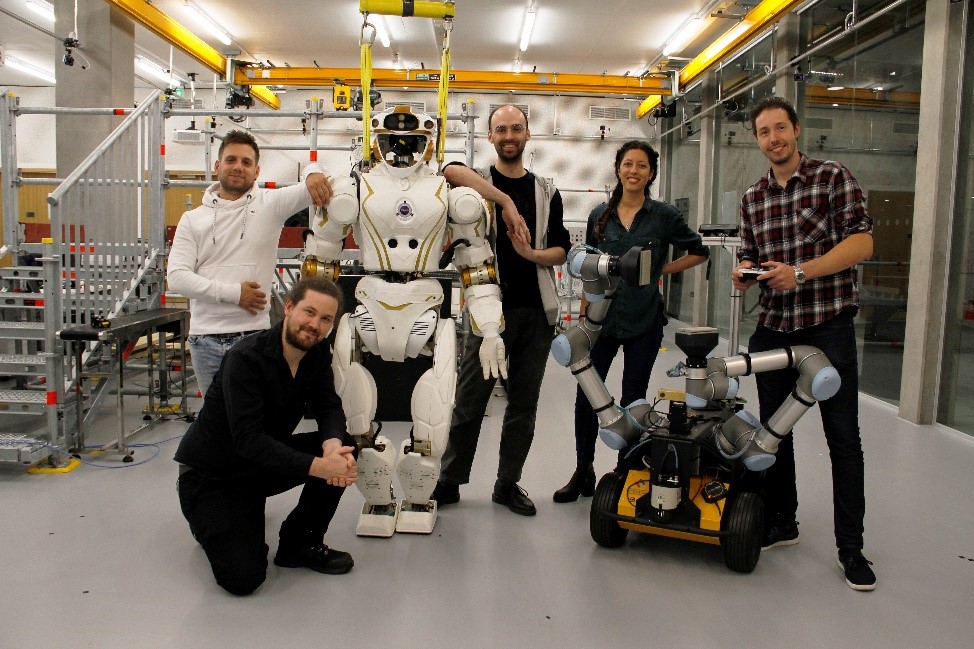
The ANA Avatar XPRIZE Competition is a global competition, sponsored by All Nippon Airways (ANA). Over 4 years, it will challenge teams around the world to develop a remotely-controlled teleoperated Avatar system. What this means is that teams will compete to develop a robot – one which will experience the world in many of the ways that humans do – that is operated remotely by a human controller. The robot should be able to use senses such as touch and smell, and move in ways that humans can. The aim of the XPrize is to solve humanity’s grand challenges – and the Avatar XPRize is about creating a more connected world.
Edinburgh-based start-up Touchlab joins 77 teams from 19 different countries around the world who have been selected for the challenge. Touchlab is the only company chosen from Scotland; and one of three from the UK as a whole.
Touchlab is based at The Higgs Centre for Innovation – a Science and Technology Facilities Council (STFC) business incubation hub, located at Royal Observatory, Edinburgh. We catch up with Touchlab’s product designer, Laura Garcia-Caberol, to find out more…
Touchlab is just over 1 year old. That’s a great achievement for such a young start-up. What has been your journey to creating this opportunity?
“Yes, we are a very young company, but things are moving extremely quickly. Our business is to give robots a human sense of touch, so we are already developing the tech that will inform how we might approach creating the Avatar for the competition.”
That’s fascinating. How does Touchlab give robots a human sense of touch?
“We have developed an electronic skin (e-skin) system which we’ve patented, and it’s called eDermis®. This skin is thinner than human skin and it can feel both the pressure and the location of that pressure, wherever it’s touched. This skin then allows a robot to handle delicate objects; feel textures; and even experience sensation such as pain.”
How is this Touchlab tech currently being used?
“The e-skin can be used both in harsh environments as well as in day-to-day scenarios. Currently eDermis® is being used by the robotics industry for warehouse roles – stacking and moving supermarket inventory. We are also exploring its use in wind and tidal turbines. Our sensors sit on top of wind and tidal turbine blades – detecting low forces of pressure such as the flow of fluid around a blade.”
So, there are exciting applications of the Touchlab e-skin tech. How do you plan to develop this to create a full avatar system for the competition?
“Our CEO Zaki Hussein is the leader of our team; and Touchlab’s key expertise is in tactile sensing, so we are bringing the tactile capability to the avatar – the sensors. To take our tech and build a full avatar system, the Touchlab team also includes many experts who have joined us as sponsors.
“For example, we are working closely with the Edinburgh Centre for Robotics, who are giving us access to lots of robotics hardware… torsos and hands, as well as vision systems, controllers, and mobile platforms…
“We also have expertise on the team in machine learning and in virtual reality (VR). For example Leap Motion Tracker is a piece of VR tech. It’s a markerless motion capture device which can track hand and finger motion in thin-air without the user having to wear anything.
“There’s also lots of other cool stuff, like brain-machine interface tech, microelectronics, materials. It’s very exciting. We are learning a lot and working with the best minds in the field… Some of our sponsors include… Quantum Technology Supersensors (for smart materials), Printed Electronics Limited (for flexible electronics fabrication), and HITEK Electronics Materials (for materials to cope in extreme environments).”
What are some of the main tech challenges in the task, for you?
“We want to integrate diverse sensing systems around the Avatar. For example the Avatar will be able to smell, touch and hear, as well as detect levels of things like radiation and humidity. All of this sensory ‘information’ would be transmitted to the controller using a VR headset.
“What this means is that, say for example we placed an Avatar in a harsh environment, like in the Australian bush fires. The Avatar would detect the smoke, and then through the VR headset the operator could be alerted with a warning, that for example, temperatures are rising to dangerous levels, or that people in the area should be evacuated.
“Wearing a VR headset, the human operator can essentially see through the robot’s eyes and make movements which the robot will make too. Say for example the human operator wants to give someone a hug – they can make the motion of the hug and Avatar will copy it – giving that person a hug. Another application for these ‘social robots’ would be to transmit smell. Your grandmother has baked a cake, and through the VR headset you can smell it. This is an enormous challenge that we are just starting by being able to transfer.”
“So we can make Avatar’s for different purposes – to go into harsh environments that would be too dangerous for a human, as well as what we call a social Avatar, one that can connect with people when you can’t be there.”
That is amazing! So, what are the next steps in the competition for you?
The competition has a series of milestones. The next one is in May 2021, where we will be challenged to demonstrate that our Avatar tech can for example detect radiation and smell; that it has tactile agility; can identify objects and navigate through extreme environments.
You are currently an incubator company at the Higgs Centre for Innovation. What does the centre offer you?
“Yes, we were successful in achieving business incubation at the Higgs Centre for Innovation. We have been really excited about the opportunity because we would also like to expand the use of our tech to the aerospace industry. The Higgs Centre for Innovation is co-located with the UK Astronomy Technology Centre as well as the University of Edinburgh’s Institute for Astronomy – and so we are rubbing shoulders with astronomers, scientist and engineers. Not only that the Higgs offers business support and also use of state-of-the-art testing facilities.
“We can therefore take our sensors and test them in harsher environments – using high-tech kit like the cryogenic facilities to test our tech in low temperatures; as well as use things like vibration shakers to test how it responds to different levels of vibration.”
“The Higgs Centre for Innovation, for us is the perfect combination of business support and access to specialist knowledge and tech facilities.”
Thank you Laura. What a fascinating journey. Good luck with the competition.
As only team to qualify for the ANA Avatar XPRIZE Competition in Scotland Touchlab is looking for expertise and funding! To find out more about how you could contribute to the team, please contact zaki@touchlab.io
You can follow Touchlab on Twitter @TouchlabL
#AvatarXPRIZE @XPRIZE
